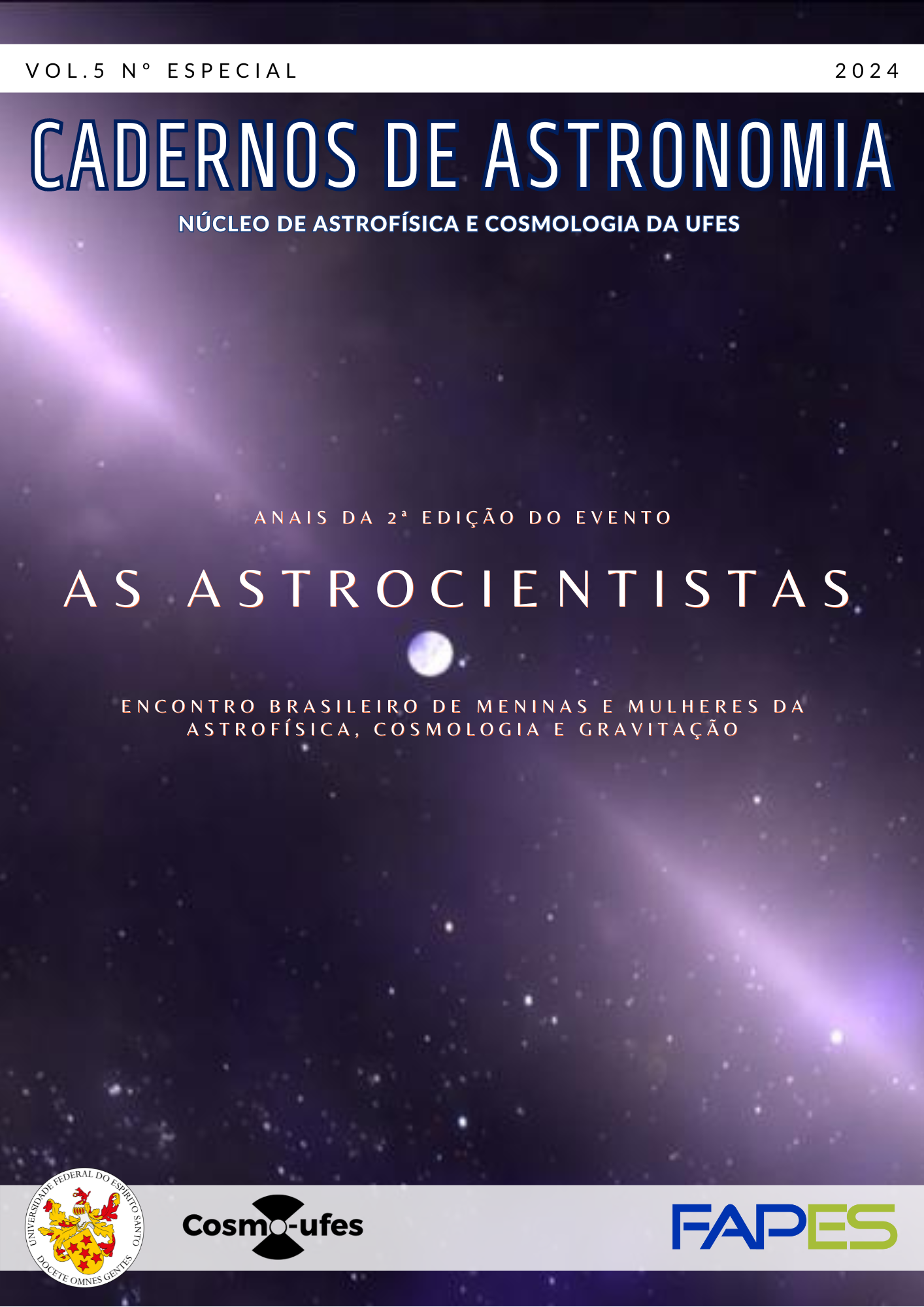Estudo de deflexões de UHECR na presença do campo magnético galáctico JF2012
DOI:
https://doi.org/10.47456/Cad.Astro.v5nEspecial.44960Palavras-chave:
Astrofísica extragaláctica, raios cósmicos, campos magnéticosResumo
A produção e aceleração de raios cósmicos de altas energias (Ultra-high energy cosmic rays - UHECR) no Universo continua sendo um dos grandes mistérios da ciência moderna. Os mecanismos de aceleração de partículas altamente energéticas em fontes astrofísicas são ainda desconhecidos. O principal objetivo deste estudo foi explorar a distribuição de emissão e chegada de UHECR originadas de radiogaláxias. Utilizou-se como possíveis fontes as radiogaláxias Centaurus A, Fornax A e M87 devido a sua correlação com a direção de chegada de eventos medidos do Observatório Pierre Auger. Explorou-se as potencialidades de detecção dessas partículas considerando o efeito do modelo do campo magnético Galáctico Jansson-Farrar 2012 (JF2012). O estudo da influência do campo magnético auxilia na compreensão da geração e propagação dos UHECR. Para o estudo, foi utilizado o programa computacional Cosmic Ray Transport (CRT), o programa não considera perdas de energia, mas foi utilizado para a quantificação dos desvios das partículas a partir dos seguintes parâmetros: rigidez da energia, distância da fonte à Terra, direção da fonte no céu e carga/massa da partícula a ser propagada. Os resultados obtidos quantificam o efeito do campo magnético Galáctico nas diferentes direções das radiogaláxias e indicam que o campo Galáctico deve ser considerado a partir de energias próximas a 16 EeV.
Referências
M. C. Bustamante, A descoberta dos raios cósmicos ou o problema da ionização do ar atmosférico, Revista Brasileira de Ensino de Física 35(2), 2603 (2013). Disponível em https://doi.org/10.1590/S1806-11172013000200030.
J. Linsley, Evidence for a Primary Cosmic-Ray Particle with Energy 1020 eV, Phys. Rev. Lett. 10, 146 (1963). Disponível em https://link.aps.org/doi/10.1103/PhysRevLett.10.146.
R. Alves Batista et al., Open Questions in Cosmic-Ray Research at Ultrahigh Energies, Frontiers in Astronomy and Space Sciences 6 (2019). Disponível em http://dx.doi.org/10.3389/fspas.2019.00023.
R. C. dos Anjos et al., Ultrahigh-energy cosmic ray composition from the distribution of arrival directions, Phys. Rev. D 98, 123018 (2018). Disponível em https://link.aps.org/doi/10.1103/PhysRevD.98.123018.
J. H. Matthews et al., Fornax A, Centaurus A, and other radio galaxies as sources of ultrahigh energy cosmic rays, Monthly Notices of the Royal Astronomical Society 479(1), L76 (2018). ArXiv:1805.01902.
Y. B. Bandeira e L. F. Mackedanz, Mecanismos de limitação da energia de raios cósmicos durante sua propagação, Revista Brasileira de Ensino de Física 41(4), e20190118 (2019). Disponível em https://doi.org/10.1590/1806-9126-RBEF-2019-0118.
A. Castellina, AugerPrime: the Pierre Auger Observatory Upgrade, EPJ Web of Conferences 210, 06002 (2019). Disponível em http://dx.doi.org/10.1051/epjconf/201921006002.
R. d. C. d. Anjos, Propagação de raios cósmicos extragaláticos., Tese de Doutorado, Tese (Doutorado em Física Básica) - Instituto de Física de São Carlos, Universidade de São Paulo, São Carlos (2014).
J. P. Armand, Anisotropias no fluxo de Raios Cósmicos de Ultra Altas Energias. (2018).
F. M. Rieger, Active Galactic Nuclei as potential sources of ultra-high energy cosmic rays, Universe 8(11), 607 (2022).
A. Keivani, G. R. Farrar e M. Sutherland, Magnetic deflections of ultra-high energy cosmic rays from Centaurus A, Astroparticle Physics 61, 47–55 (2015). Disponível em http://dx.doi.org/10.1016/j.astropartphys.2014.07.001.
S. R. Ehlert et al., Limits on X-Ray Polarization at the Core of Centaurus A as Observed with the Imaging X-Ray Polarimetry Explorer, The Astrophysical Journal 935(2), 116 (2022). Disponível em http://dx.doi.org/10.3847/1538-4357/ac8056.
B. Duah Asabere et al., Mid-infrared dust in two nearby radio galaxies, NGC 1316 (Fornax A) and NGC 612 (PKS 0131-36), Astronomy & Astrophysics 592, A20 (2016). Disponível em http://dx.doi.org/10.1051/0004-6361/201528047.
C. d. OLIVEIRA, Fontes locais de raios cósmicos ultra energéticos. (2021).
G. Farrar, The Galactic Magnetic Field and its lensing of Ultrahigh Energy and Galactic Cosmic Rays, in IAU General Assembly (2015), vol. 29, 2258479.
G. R. Farrar, The Galactic magnetic field and ultrahigh-energy cosmic ray deflections, Comptes Rendus Physique 15(4), 339 (2014), ultra-high-energy cosmic rays: From the ankle to the tip of the spectrum. Disponível em https://www.sciencedirect.com/science/article/pii/S1631070514000498.
M. Unger e G. Farrar, The coherent magnetic field of the Milky Way (2023). ArXiv:2311.12120.
R. Jansson e G. R. Farrar, The galactic magnetic field, The Astrophysical Journal 761(1), L11 (2012). Disponível em http://dx.doi.org/10.1088/2041-8205/761/1/L11.
R. Jansson e G. R. Farrar, A new model of the galactic magnetic field, The Astrophysical Journal 757(1), 14 (2012). ArXiv:1204.3662.
M. S. Sutherland, B. M. Baughman e J. J. Beatty, CRT: A numerical tool for propagating ultra-high energy cosmic rays through Galactic magnetic field models, Astroparticle Physics 34(4), 198 (2010). ArXiv:1010.3172.
Downloads
Publicado
Edição
Seção
Licença
Copyright (c) 2024 Larissa Cristina Santos, Rita de Cássia dos Anjos

Este trabalho está licenciado sob uma licença Creative Commons Attribution 4.0 International License.






